
The Grounds Guys provide insights on heat-resistant grasses.
|
Maintaining a healthy and beautiful-looking lawn requires time and effort, but it starts with having the right grass for your climate. If you live in an area that experiences high temperatures, you need grass that will not only survive the heat but thrive in it. Unlike their cool-season counterparts, warm-season grasses thrive in the heat. In fact, their peak growing season is the middle of summer. Additionally, many — but not all — warm-season grasses are drought tolerant. Read on to learn more about the best grass for hot weather.
Table of Contents:
The Best Warm-Season Grasses
When it comes to choosing the right warm-season grass for your property, you have several choices. Each has its own distinct look and feel, so choosing the right one is often a matter of personal preference. Here’s a closer look at some of the best warm-season grasses.
Bermuda Grass
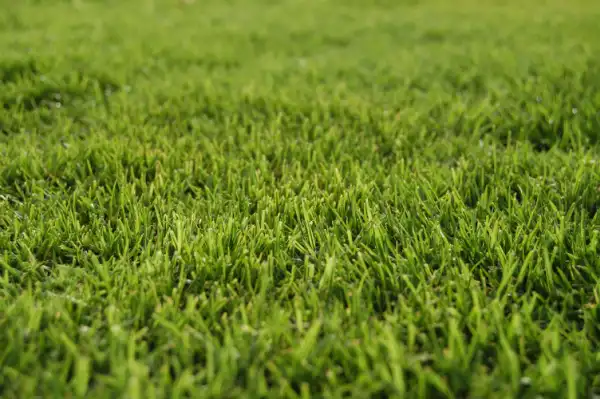
This popular type of grass is grown throughout North America. Varieties bred to grow in the south are the most drought-tolerant. Bermuda grass loves the sun, withstands high traffic, and reacts quickly to watering after a dry spell. During the growing season, Bermuda grass requires frequent mowing. It goes dormant in warm winter climates, at which time you can overseed with ryegrass to maintain a green lawn all winter long.
The most drought-tolerant and heat-tolerant varieties of this grass species include:
- Common Bermuda
- Celebration
- GN1
- Grimes EXP
- TexTurf
- TifSport
- Tifway 419
St. Augustine Grass
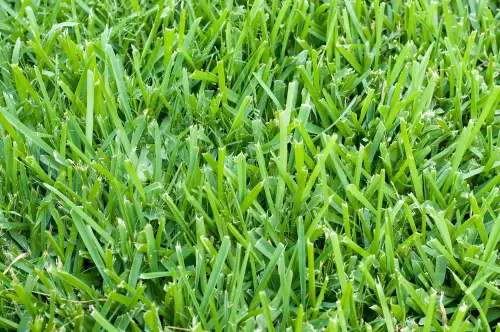
This coarse-leaf grass is the most popular variety in Florida. Residents of the Gulf Coast, Africa, and the Pacific Islands also praise it for its heat tolerance. St. Augustine grass prefers dappled shade and withstands moderate traffic. It remains green throughout winter dormancy without much water. In fact, this species is susceptible to disease if you overwater during winter, so save time and money, and avoid watering St. Augustine grass while it’s dormant.
The most drought-tolerant and heat-tolerant cultivated variety of this species is Floratam.
Zoysia Grass
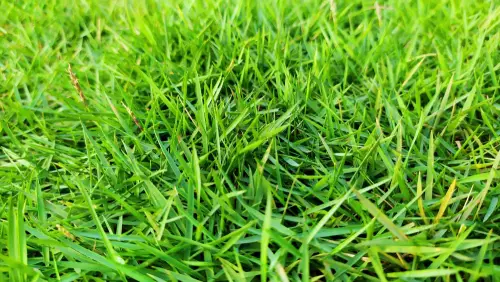
This slow-growing grass provides a lush, green carpet of turf once it’s fully established. You don’t have to mow or water Zoysia grass often, so maintenance time and costs are minimal. This grass tolerates both sun and shade and stands up well to foot traffic.
The most drought-tolerant and heat-tolerant cultivated varieties of this species include:
- El Toro
- Empire
- Jamur
- Palisades
Buffalo Grass
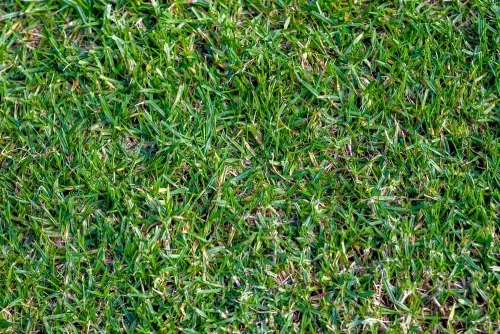
Native to the Midwest, buffalo grass is an excellent choice for low-water landscaping. It requires full sun and very little — if any — water once fully established. This grass grows naturally across the plains from Mexico to Montana and once fed herds of buffalo as they roamed these areas, hence the name. Keep in mind that buffalo grass doesn’t tolerate foot traffic well and must be kept at a height of five inches or longer to remain healthy.
Centipede Grass
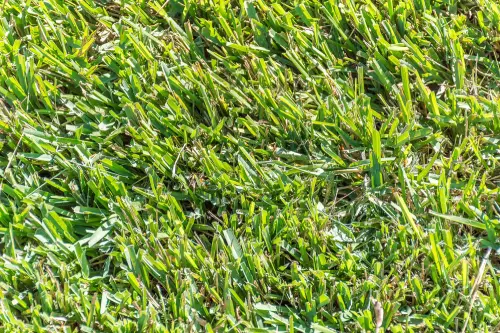
Introduced to the US in 1916 from Southeast Asia, Centipede grass is a hardy, slow-growing grass that provides a low-maintenance lawn once fully established. It prefers full sun or partial shade, but its ability to survive in acidic soil makes it a popular choice for the dappled shady area under pine trees.
Bahia Grass
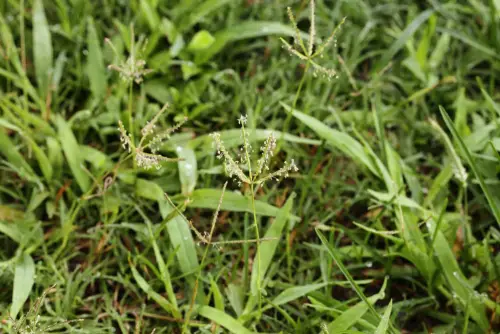
An all-purpose grass with excellent tolerance to foot traffic, Bahia grass resists pests and disease and grows impressively well in poor soil, though it requires full sun to thrive. This is a great heat-resistant grass because its prolific root system helps it find water deeper down than other grasses.
Carpet Grass

Carpet grass is a low-maintenance, warm-season grass that can survive on even the most challenging pieces of land. It grows in just about any soil, including wet soils that drain poorly and seldom dry out completely. It makes the list of best grass for hot weather because it forms a dense mat to keep weeds at bay (thus the name), so there is less weeding for you! Though it’s not drought tolerant, it can be the right choice if you have poor soil conditions and growing healthy grass in your yard is a challenge.
Fescue Grass
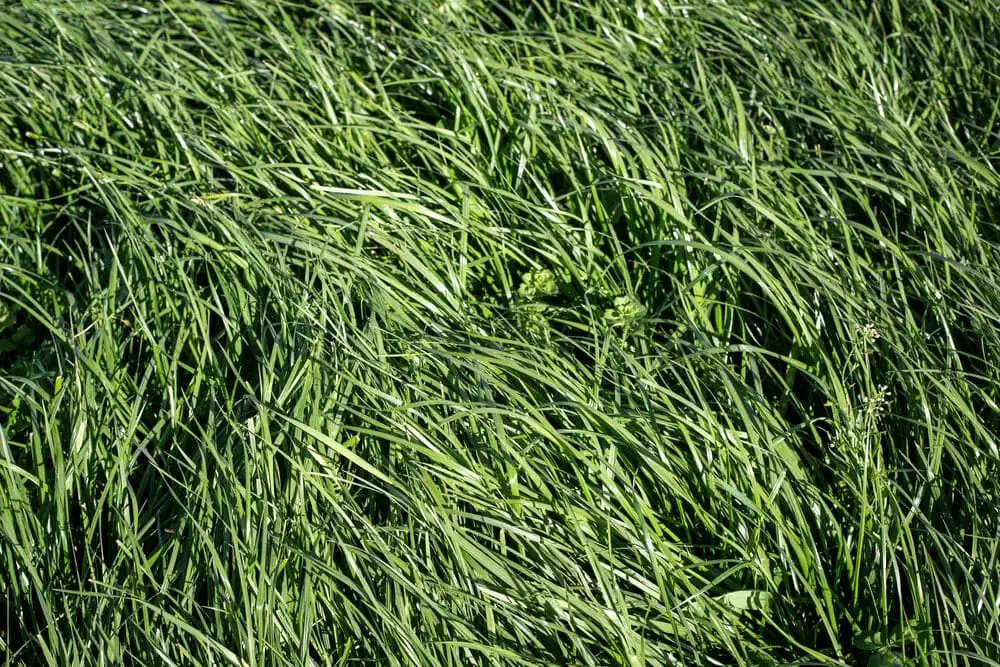
Although fescue grass is a cool-season grass, it’s also heat, cold, and drought tolerant. It’s a good grass option for those living in areas that experience both warm and cool seasons. And, since it can withstand some wear and tear, it’s an excellent choice for areas with heavy foot traffic. This species has several seed varieties that include the following:
- Tall Fescue Grass
- Creeping Red Fescue Grass
- Hard Fescue Grass
- Chewings Fescue Grass
- Sheep Fescue Grass
Switchgrass
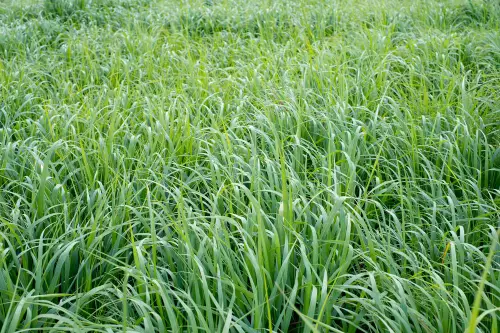
Switchgrass is an excellent low-maintenance grass that can add interest to home and commercial landscapes. Its foliage features blade-like leaves that come in metallic blue, olive green, or blue-green shades before turning bright yellow or golden in fall. This grass is also planted in mass on slopes and hillsides to control erosion and it creates a colorful and interesting backdrop.
Crabgrass
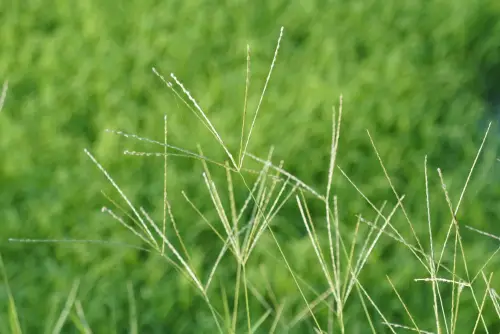
When it comes to summer grasses, Crabgrass gets a bad rap. After all, it can be invasive and tends to crowd out other grasses like Bermuda. But it does well in poor soil and is highly nutritious, so farmers use it for cows and other animals to graze on. Grass-fed beef, anyone? Crabgrass is very drought-tolerant; in fact, it loves the heat! Sure, it’s seedy, but the seeds are often used as grain or flour and can even be fermented to make beer.
Indian Grass
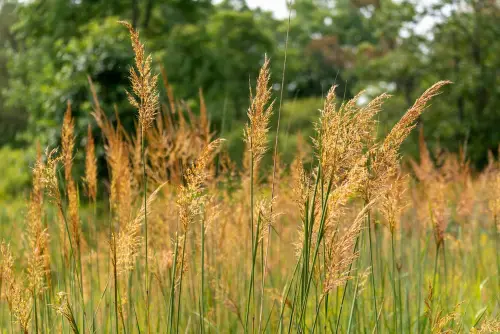
Indian grass is a North American native grass that stands tall and looks magical when there’s a light summer breeze. It doesn’t need much maintenance and grows well in a variety of soils. It’s an attractive warm-season grass that can be used to form ornamental borders or add drama to your landscape. If erosion is a problem in certain areas of your landscape, Indian grass can be used to stabilize the soil.
Pro Tip: Remember, you can increase the drought and heat tolerance of any grass by watering infrequently but deeply, providing nutrient-rich soil, and keeping the grass a bit longer to shade the ground beneath it.
Get Your Lawn Ready for Summer with the Right Grass Type!
Summertime is fun for all, especially when you have a beautiful landscape everyone can enjoy. The Grounds Guys® can help with that.Find The Grounds Guys location nearest you and request a free estimate. Let us know what your lawn goals are and we’ll analyze your landscape, soil, and sun exposure and then provide a recommendation for the best heat-resistant grass for your yard. and if you need help with more than just your lawn, we’ll discuss the landscape services that will be most beneficial to you. We provide excellent lawn care and landscape maintenance, including mowing, fertilization, mulching, weeding, and more.
All of our services are backed by the Neighborly Done Right Promise™, which means your satisfaction is guaranteed. Contact us today for a healthier lawn and a beautiful landscape you can enjoy throughout the year!
FAQs About Warm Season Grasses
Our 200 franchise locations across the U.S. and Canada share a common goal — using our years of experience and expertise to help you bring the vision for their property to life. This includes answering questions you have about landscaping and lawn care. Below are answers to some of the most frequently asked questions about warm-season grasses.
Which warm-season grasses tolerate heat the best?
The top performers for extreme heat conditions are Bermuda grass, Zoysia grass, and buffalo grass. Bermuda grass stands out, with drought-tolerant varieties like Common Bermuda, Celebration, and Tifway 419 that can withstand temperatures well over 100°F while maintaining active growth. Zoysia grass offers exceptional heat tolerance once established, requiring minimal watering even during peak summer months.
Native warm-season grasses also excel in heat. These warm-season grass types enter their peak growing season during midsummer when cool-season varieties struggle or go dormant:
- Buffalo grass thrives naturally from Mexico to Montana, requiring virtually no irrigation after establishment.
- Blue grama grass tolerates the extreme temperature swings common in prairie climates.
- Indian grass maintains its structure even during prolonged heat waves.
What characteristics make Zoysia and Bermuda grass ideal for hot climates?
Bermuda grass has several natural advantages that allow it to thrive in hot weather. Its deep root system can extend 6 feet underground, accessing moisture unavailable to shallow-rooted grasses. The dense growth pattern creates natural shade for the soil, reducing water evaporation. In addition, Bermuda grass bounces back quickly from heat stress when watered, making it perfect for areas with inconsistent rainfall.
Zoysia grass excels through different mechanisms. Its thick, waxy leaf blades reduce water loss through transpiration, while the dense growth habit creates a living mulch that keeps soil temperatures cooler. Zoysia's slow growth rate actually becomes an advantage in heat, allowing the grass to conserve energy during stress periods rather than pushing new growth that would require more water.
Both grass types can handle full sun exposure for 8+ hours daily without burning, unlike cool-season grasses that require afternoon shade in hot climates.
How do native grasses like buffalo grass and blue grama help with drought resistance?
Buffalo grass and blue grama evolved in the Great Plains region, where they developed extraordinary survival mechanisms for extreme heat and drought conditions. Unlike traditional lawn grasses that require consistent irrigation, these natives can remain green during moderate droughts and recover quickly when rain returns, making them ideal for full sun grass seed applications in challenging climates.
Buffalo grass has an extensive root system that spreads both deep and wide, with some roots reaching 6 feet deep. This allows the grass to tap groundwater, reducing the need for rainwater. In fact, buffalo grass can survive on as little as 10 inches of annual rainfall, perfect for drought-prone areas.
Blue grama grass complements drought resistance with remarkable temperature tolerance. It can survive winters as cold as -40°F and summers exceeding 110°F! Additionally, its bunch-type growth pattern allows it to capture and channel limited rainfall directly to its root zone rather than losing water to surface runoff.
Additional benefits of these native warm-season grasses include:
- No fertilizer requirements: Once established, these grasses are adapted to grow in natural soil conditions.
- Minimal mowing needs: Buffalo grass and blue grama naturally grow 4–8 inches tall.
- Superior erosion control: Deep, fibrous root systems provide excellent soil support.
- Wildlife habitat support: Native birds and beneficial insects love these grasses!
This article is intended for general informational purposes only and may not be applicable to every situation. You are responsible for determining the proper course of action for your home and property. The Grounds Guys are not responsible for any damages that occur as a result of this blog content or your actions. For the most accurate guidance, contact The Grounds Guys location nearest you for a comprehensive, on-site assessment.